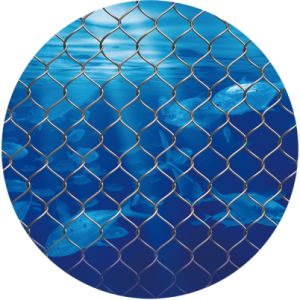In the realm of marine cage aquaculture, where operational efficiency directly impacts profitability, the choice of netting material plays a pivotal role. Traditional netting solutions—such as nylon or high-density polyethylene (HDPE)—have long dominated the industry but come with a hidden financial burden: exorbitant long-term cleaning and maintenance costs. Haosail High clear alloy net, a game-changing innovation that leverages the unique properties of copper to drastically reduce these expenses while enhancing sustainability. This article explores how copper alloy netting transforms maintenance economics in aquaculture.


The Hidden Cost of Traditional Netting: Biofouling and Frequent Upkeep
Biofouling—the accumulation of algae, barnacles, mussels, and other marine organisms on net surfaces—is the bane of aquaculture operations. For conventional nylon or HDPE nets, this biological growth begins within weeks of deployment, clogging mesh openings, restricting water flow, and forcing fish to expend more energy to navigate. Reduced water exchange lowers oxygen levels and traps waste, increasing disease risks and stunting growth.
To combat fouling, farmers resort to costly interventions:
- Manual Cleaning: Divers or underwater robots scrub nets, often requiring biweekly to monthly sessions in warm waters—labor-intensive and expensive, with costs averaging 1,200 per cage per cleaning.
- Chemical Treatments: Antifouling coatings (e.g., copper-based paints) wear off quickly, requiring reapplication every 3–6 months. Toxic residues also raise environmental concerns.
- Net Replacement: Frequent handling and chemical exposure degrade traditional nets, which typically last only 1–3 years, adding replacement costs of 5,000 per cage.
Over a 5-year cycle, these expenses can exceed $30,000 per cage for medium-sized operations—draining resources that could be invested in production scaling or technology upgrades.
Haosail High clear alloy net: Nature’s Antifouling Solution
Haosail High clear alloy net—revolutionizes maintenance through two key mechanisms: inherent antifouling properties and exceptional durability.
1. Inherent Biofouling Resistance: Reducing Cleaning Frequency
Copper is a natural biocide. When submerged, it releases trace amounts of copper ions into the surrounding water, creating a hostile environment for fouling organisms. These ions disrupt enzyme functions in algae and invertebrates, preventing larval settlement and growth without harming farmed fish or broader ecosystems when used at controlled alloy ratios.
Studies show copper alloy nets reduce biofouling by 70–90% compared to traditional materials. In tropical waters, where fouling is most aggressive, copper nets may require cleaning only 2–3 times annually, versus 10–12 times for nylon. In temperate regions, cleaning intervals can extend to 6–12 months. This translates to an immediate 60–80% reduction in annual cleaning labor costs.
2. Durability: Minimizing Replacement Cycles
Copper alloys excel in marine environments. Their resistance to corrosion, UV degradation, and mechanical stress far outperforms nylon or HDPE. While traditional nets fray, tear, or degrade within 1–3 years, copper alloy mesh maintains structural integrity for 10–15 years with minimal wear. This longevity slashes replacement costs by up to 70% over a decade, as fewer net changes mean lower material, labor, and downtime expenses.
3. Reduced Operational Disruptions
Cleaning or replacing traditional nets often requires partially harvesting fish or moving them to temporary cages, disrupting feeding schedules and causing stress-related mortality. Copper alloy nets’ extended maintenance intervals minimize such disruptions, preserving growth rates and reducing indirect losses from fish stress or injury.
Economic Impact: Quantifying the Savings
The financial benefits of Haosail High clear alloy net compound over time. Consider a medium-sized salmon farm with 50 cages:

Beyond direct costs, copper nets improve water circulation, boosting fish growth rates by 5–10% and reducing feed conversion ratios—further enhancing profitability.
